Thyme (Thymus)
By Debs Cook
History
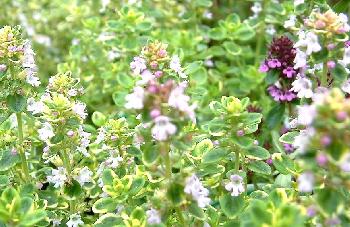
Thyme was a popular herbal remedy for the Egyptians, Greeks, and Romans, its principal medicinal use was to help soothe headaches, digestive problems, and respiratory complaints. As an antiseptic, it was strewn about or worn on clothes to ward off everything from plague to lice. In addition to its medicinal use, thyme has also long been a favorite mood-enhancing herb and a cooks' favorite.
In ancient Egypt, thyme oil was used for embalming, and the herb has long been appreciated for its ability to preserve meat. The Romans used it to treat melancholy; whilst other herbalists have favored it for treating nervous conditions and insomnia. Nicholas Culpeper claimed Thyme was not only a "noble strengtheners of the lungs" but also it "helps to revive and strengthen both body and mind." In the later part of the 19th century, thyme was used to disinfectant sick rooms as well as to promote the recovery of convalescing patients. Thyme has also traditionally been used to repel insects, prevent nightmares, kill intestinal worms, disinfect wounds and alleviate diarrhea in children.
Folklore
Thyme is said to bring healing or love to those that require it. It is also reputed to bring courage to the heart. In medieval times knights wore scarves embroidered with a bee hovering over a sprig of thyme as a symbol of their courage. Thyme is purifying and when placed beneath the pillow can bring restful sleep to those suffering from insomnia. Shakespeare claimed that thyme was a herb you'd find in fairy beds. In some parts of the world, it is believed that simply carrying thyme will help you to see fairies whilst in others, it is believed to guarantee you passage into the next life.
Description
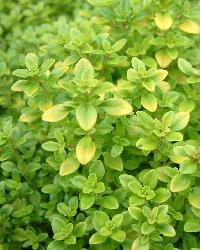
Thymus Vulgaris 'Aureus'
Thyme is a member of the mint family and is a perennial herb that includes wild, orange, woolly, and broad-leafed varieties and more than 400 others including caraway, coconut, lavender, camphor, and nutmeg. One of the best-known thyme varieties is lemon thyme - a thick ground covering thyme with a wonderful zesty lemon fragrance and flavor. Common thyme forms small bushes whilst silver thyme is low growing. Caraway thyme forms a mat and creeping thyme just exactly what it says on the label.
Thymes have wonderful flowers in a variety of colors which are another herbal magnet for bees and butterflies.
Thyme thrives in hot, dry, climates reaches a height of approximately 30 cm (12in) and is best suited either to the rock garden or the front of a border. Sometimes it is grown between cracks in walls and paths; it is highly aromatic, add to that the pretty flowers and you have a rather worthwhile addition to any garden.
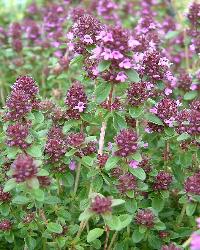
Thymus Vulgaris
Growing
Thyme prefers well-drained light soil, it should not be too rich in nutrients which will only make the plant 'leggy' and lose its compact shape. A native of the Mediterranean thyme needs to be in full Sun. It requires very little attention - water only in very dry conditions and feeds sparingly. Mulching with homemade compost around October will help protect thyme from severe frosts and will also provide most of their feeding needs. If you don't have any compost to hand then a handful of bonemeal per plant in May - July will do the trick. Thyme will start to become woody and produce fewer leaves after three or four years and, at this stage, the plant should be divided and replanted.
Preserving
You can harvest thyme all year-round, although the best flavor is in the months of June and July. In winter the plants stop growing, so harvest only lightly. Thyme sprigs can be frozen or dried - both methods retain the original flavor.
To dry, lay the stems of thyme flat or hang them in bunches in a dark, warm, dry place, I use my airing cupboard, but anywhere that's shady and isn't damp will be fine. When your thyme is dry, strip the dry leaves from the stems and store them in an airtight container. To freeze, place the thyme on a baking sheet and open freeze, then store an airtight container in the freezer.
General Use
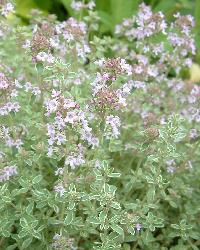
Thymus Argenteus
Thyme has strong disinfectant and anti-bacterial qualities. You can make an infusion of thyme leaves and add to the mop bucket when mopping the kitchen floor, or pour the infusion down the sink to sweeten and disinfect the drains to add a wonderful herbal aroma to the kitchen. Add the fragrant dried leaves to potpourri and put in scented sachets for cupboards and draws to help repel insects.
Medicinal Use
Thyme remains a popular remedy for sore throats, laryngitis, and dry coughs. Herbalists also recommend it for other respiratory ailments such as whooping cough and bronchitis. Thyme is also used as a digestive aid. Aromatherapists often recommend the essential oil for people suffering from mental stress, PMT, fatigue, and depression. The oil is anti-microbial and can be diluted and used topically for infections. You should avoid taking large amounts of Thyme in pregnancy, although the amounts used in cooking are perfectly safe.
Cosmetical Use
Thanks to antioxidant, anti-fungal, and anti-bacterial properties, Thyme (Thymus Serpyllum) extract is a safe and effective ingredient for sun protection and skincare formulas, protecting skin from harmful free radicals, bacterial and fungal infections.
Culinary Use
Thyme is superb in recipes that call for long, slow cooking as it is one of the few herbs that won't lose its flavor when cooked for a long time. Sprigs of thyme can be placed in the water of steamed or boiled vegetables or used to make thyme-scented vinegar and oils. Fresh leaves and flowers can be used in salads and as garnishes, and you can use the leaves, fresh or dried, for making thyme butter and cooking oil. Add lemon thyme to chicken breasts with a drizzle of olive oil and some freshly milled pepper to make a wonderfully aromatic chicken dish for supper or lunch. Strip the leaves from stems when using fresh. Chopped fresh leaves are much more pungent than dried so use sparingly if substituting fresh for dried in a recipe.
Recipe
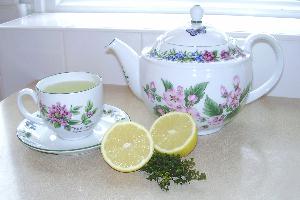
Lemon Thyme Throat Soother
This month I have a medicinal recipe for you to try. It is ideal for helping to ease a sore throat and is simple in itself to make.
Quantities
- 1 Tsp Dried Lemon Thyme or 1 Tbsp fresh leaves.
- 1 Litre Organic Lemonade.
- Honey to serve.
Method
Lemon thyme (or any thyme come to think of it) makes a wonderful cold cure, my favorite way to soothe a cold is to
- bring a liter of organic lemonade to the boil in a pan
- add some fresh or dried lemon thyme leaves and let them steep for 15-20 minutes
- add a teaspoon of honey and warm it through again if needed
Sip it slowly to help with a sore throat and to ease nasal congestion. You can use any sort of lemonade but I've found that real lemon organic stuff is the best.
